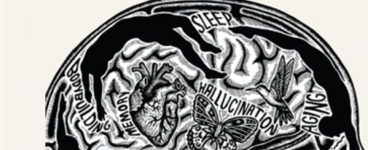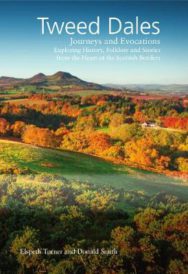‘This meteoric rise was lent some serendipitous aid by literary neighbours, Sir Walter Scott and James Hogg.’
Extract from Tweed Dales: Journeys and Evocations Exploring History, Folklore and Stories
from the Heart of the Scottish Borders
by Donald Smith and Elspeth Turner
Published by Luath Press
Journey 4: Galawater, Wedale and Lauderdale
North of the Tweed we travel up the Gala Water and down the Leader Water. The two rivers are hemmed in by hills to the west and east and so most travellers used, as now, these river valleys and the hills between them. Routes ran close to and beneath today’s roads or walking paths. The drove roads for cattle and the Herring Road from the coast, crisscrossed the hills to connect with them.
The numerous Celtic British hill enclosures, Roman fortlets and camps, and the tower houses that later lined these routes indicate that defence of this narrow corridor mattered greatly to whichever overlord had control. The need for military defence waned after the Union of the Crowns in 1603, disappearing with the Union of the Parliaments in 1707, but even before then life on this side of the Tweed was generally more peaceable than to the south – not least in the centuries after David, Earl of Northumbria, was crowned David I of Scotland in 1124.
For most of this time Wedale and Lauderdale folk shared the hills with thousands of sheep belonging to one or other of the Border Abbeys. Until the abbey lands passed into private hands after the Reformation, relatively little land was held by non-monastic tenants. At some distance from the border with England there was also less threat from marauding armies. While the reiving dynasties south of the Tweed were stealing cattle from one another and carrying out cross border raids, the people of Lauderdale gained an early reputation for settling disputes through the courts. That is not to say that life in Wedale and Lauderdale was uneventful or that all conflicts were resolved bloodlessly. There were battles and family feuds, but these were usually sparked by political events and religious differences.
Things were less peaceful before the arrival of monastic flocks. In the 7th century, the Anglo-Saxon Northumbrians wrested control of the lands between the Tweed and the Firth of Forth from the Celtic British. Physical and diplomatic tussles for control continued until a mid-10th century deal was struck. This merged several kingdoms to create England, relinquished the lands north of the Tweed to the Scots, and reduced the Kingdom of Northumbria to an earldom. By the time David was crowned King of Scotland, the border had settled along the Cheviots and the eastern end of the Tweed.
So, for nearly five centuries, the people who lived in Wedale and Lauderdale were either on the edge of the Kingdom of Northumbria or outside it. This may explain why Anglo Saxon influence on place names and settlement patterns here is minimal and why English replaced Cymric, the language of the Celtic British, more slowly than south of the Tweed. The area was also until the 19th century more sparsely populated than lands to the south. These continuities may explain why a Galashiels accent is still distinguishable from accents heard in nearby Selkirk, Melrose and Peebles.
Travel in and out of these parts was not undertaken lightly before toll-funded turnpike roads and bridges connected Edinburgh with Carlisle and Jedburgh in the late 18th century. Roman Dere Street was repaired periodically to serve as a military route, but generally roads were rough tracks and frequently impassable. And there was the added challenge of getting across the Tweed. There were few bridges and in fact, for a long time, none between Peebles and Kelso. And so, for millennia, these dales grew men for fighting, cattle and, latterly, sheep. Although the abbeys sowed the seeds of the textile industry that transformed the central Borders in the 19th century, government policies to reduce reliance on imported goods and maximise exports created the conditions for growth. Skilled textile workers were enticed from abroad with promises of tax breaks and special privileges, and steps were taken to stimulate and protect domestic production (for example by insisting Scots had by law to be buried in a shroud of Scottish linen). By the 1770s, the country had a sizeable textile industry. The mechanisation of spinning and weaving processes over the next 50 years revolutionised production and transformed the small, unremarkable burgh of Galashiels into a dynamic industrial town exporting high quality cloth across the globe.
This meteoric rise was lent some serendipitous aid by literary neighbours, Sir Walter Scott and James Hogg. They popularised the distinctive shepherd’s check pattern and later tartan. The association of woven woollen cloth with the area was further strengthened through the misreading by a clerk of ‘tweel’ (an alternative term for twill) as ‘tweed’. Whether this came about as a consequence of bad handwriting or poor eyesight is unknown but the name stuck! By the mid-19th century, a sparsely populated area, largely bypassed by the 18th century agricultural advances, became one of the most dynamic in Scotland. Road improvements and the coming of the railway provided a further boost.
Although later agricultural changes and ups-and-downs in the textile industry led to many people leaving in the 19th century, more came than left. However, the 20th century wars, a decline in demand for the products of the mills and the closure of the railway for 46 years, brought challenging times to the Leader and Gala Water valleys. After a bumpy ride through the second half of the 20th century, the area is back on the rails metaphorically, and, with the reopening of the Waverley railway line to Tweedbank in 2015, literally.
Tweed Dales: Journeys and Evocations Exploring History, Folklore and Stories from the Heart of the Scottish Borders by Donald Smith and Elspeth Turner is out now published by Luath Press priced £12.99
ALSO IN THIS ISSUE

 Shapeshifters: On Medicine and Human Change
Shapeshifters: On Medicine and Human Change
‘In growth and in recovery, in adapting and in ageing, our bodies ineludibly change form – and with …

 Heart Fire by Johannes Hartl
Heart Fire by Johannes Hartl
‘This simple and self-evident attitude towards life seems almost strange.’













